An Introduction to Shinran’s Pure Land Buddhism
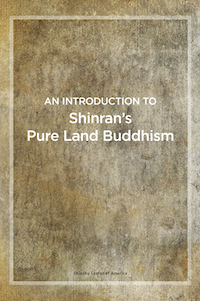
- Edition: 1st
- Published: 2016
- ISBN: 978-0-692-71418-8
- Price: US$18.00
- Originally published in Japanese in 1989 as Jōdo no Shinshū: Shinshū Gaiyō by Shinshū Ōtani-ha Kyōshi Yōsei no Tame no Kyōkasho Hensan Iinkai (Kyōshi Textbook Editorial Committee)
[From the Preface]
In what kind of age are we now living?
In our society based on the culture of science, science is progressing, which may appear to be a victory of the human intellect. -However, among this scientific progress, problems such as environmental pollution, global warming, and the ill effects of nuclear power generation are coming to the surface. Many people suffer estrangement from their homes and families, as the great calamities brought about by the 2011 earthquake in Eastern Japan have showed us. Are we not living in mappō, in an age of ignorance?
In order to live in this age of calamity and confusion, an age where we feel we are drifting alone, we need the spiritual foundation that -Shinran Shōnin clarified for us as Jōdo no Shinshū. Fortunately, the Japanese textbook Jōdo no Shinshū has been translated into English by the staff members of the Shinshu Center of America. I sincerely hope everyone who is interested in Shin Buddhism will read it.
Footsteps Through History: The Story of Shinshū Ōtani-ha

- Edition: 1st
- Published: 2018
- ISBN: 978-0-9995266-1-3
- Price: US$18.00
- Originally published in Japanese in 1986 as Kyōdan no ayumi: Shinshū Ōtani-ha kyōdanshi by Shinshū Ōtani-ha Kyōshi Yōsei no Tame no Kyōkasho Hensan Iinkai (Kyōshi Textbook Editorial Committee)
[From the Preface]
The history of those who have sought the truth predates the time of the Buddha. Even the Buddha said he did not create the living truth (Dharma) he was awoken by: it was always there. Since then the Dharma undercurrent to Buddhism has been realized and shared by countless numbers of people throughout its history. This book attempts to contextualize the flow of Dharma undercurrent to the history of the Honganji as an expression of Japanese Buddhism. In particular, it will present the story of the Shinshū Ōtani-ha (Higashi Honganji). By telling the story of our followers, the
followers of the nenbutsu of the original vow, it is not our intention to make the history of shinjin exclusive to the history of the Higashi Honganji. By learning more about our own history, we can become spiritually independent and live our lives according to the teaching. In this process, as members of the Shinshū Ōtani-ha, we must keep asking ourselves whether or not we have truly realized the living Dharma undercurrent to our lives.
Traditions of Shinshū Ōtani-ha: An Introduction to Its Rituals and Chanting
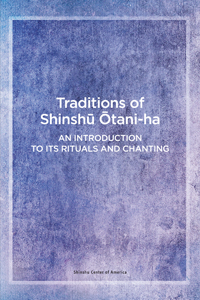
- Edition: 1st
- Published: 2019
- ISBN: 978-0-9995266-3-7
- Price: US$18.00
- Originally published in Japanese in 1998 as Shinshū no gishiki: Shōmyō sahō by Shinshū Ōtani-ha Kyōshi Yōsei no Tame no Kyōkasho Hensan Iinkai (Kyōshi Textbook Editorial Committee)
[From the Preface]
The Traditions of Shinshū Ōtani-ha: An Introduction to Its Rituals and Chanting is one of the textbooks for training kyōshi priests (fully ordained priests) of the Shinshū Ōtani-ha (Higashi Honganji) denomination. The focus of this book is on the rituals, especially on the protocols for shōmyō (chanting), of the Shinshū Ōtani-ha.
In Article 2 of the Shūken (Constitution of the Shinshū Ōtani-ha), the objectives of the denomination is provided as follows:
The Denomination shall, following Shinran Shōnin’s spirit of founding the Denomination, proclaim the teaching and dharma, perform rituals, undertake other activities necessary for the kyōka (to deepen one’s understanding of the Shin Buddhist teaching through oneself and also to guide others to the understanding), and thereby aim to realize the dōbō (fellow followers) society.
The Shūken (Constitution of the Shinshū Ōtani-ha), Article 2
As stated in the article above, performing rituals, as well as proclaiming the teaching and dharma, is the primary duty of kyōshi priests of the Shinshū Ōtani-ha. Therefore, it is incumbent on all kyōshi priests to understand the significance of performing rituals and to acquire chanting proficiency.
December Fan: The Buddhist Essays of Manshi Kiyozawa
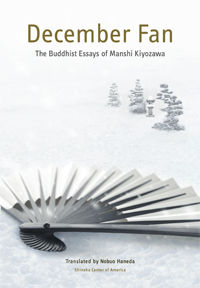
- Edition: 2nd
- Published: 2014
- ISBN: 978-0-615-65763-9
- Price: US$12.00
[From the Introduction]
This book introduces the reader to the thought of Manshi Kiyozawa (1863 – 1903), one of the most important Japanese Buddhist figures of modern times. Kiyozawa was a Buddhist minister belonging to the Ōtani-ha (or Higashi Hon- ganji) sect of Shin Buddhism (Shinshū). He exerted considerable influence upon the direction of modern Japanese Buddhism, although he died at the relatively young age of forty. The eminent philosopher Kitarō Nishida (1870 – 1945) called Kiyozawa one of the most important figures in modern Japanese religious philosophy. Modern Shin Buddhist doctrine can hardly be discussed in isolation from Kiyozawa. His writings have also been the source of inspiration for later generations of Shin followers, scholars, and reformers.
The Teaching of Shin Buddhism and the History of the Honganji Sangha: A Handbook for Shinshū Followers

- Edition: 1st
- Published: 2020
- ISBN: 978-0-9995266-4-4
- Price: US$10.00
- Originally published in Japanese in 2018 as Shinshū no oshie to shūmon no ayumi by Higashi Honganji Shuppan in Kyoto
[From the Preface]
The Japanese version of this book was published as study material for the members of the Subdistrict Lay Committee (so montokai). The Subdistrict Lay Committee, which is composed of lay members who represent their temples located in the Subdistrict (so), is organized to discuss their activities and to help with the administrative matters of their Subdistrict for the purpose of the propagation of the teaching….This book has been compiled so that it can be of help to the Subdistrict Lay Committee members in deepening their understanding of the meaning and roles of the committee. For these purposes, the topics we have selected for the contents of this book are: “What is the Dōbōkai Movement?” “The Life of Our Spiritual Forebear Shinran Shōnin,” “The Teaching of Jōdo Shinshū—Learning through the Shōshinge,” “The Life of the Shinshū Followers—The Life Centered around the Onaibutsu,” “The History of Our Shūmon,” and “The Dōbōkai Movement of Today,” along with some additional learning materials.
The Rules of the Shinshū Ōtani-ha
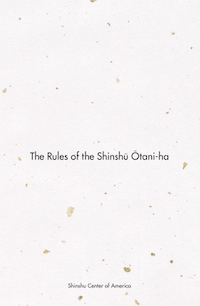
- Edition: 1st
- Published: 2021
- ISBN: 978-0-9995266-5-1
- Price: US$10.00
This book is a compilation of the English translations of some rules and regulations of the Shinshū Ōtani-ha (Higashi Honganji) denomination in Japan. It includes the full translations of the following rules:
- The Constitution of the Shinshū Ōtani-ha (Shinshū Ōtani-ha Shūken)
- The Bylaws of the Shinshū Ōtani-ha, a Religious Corporation (Shūkyō Hōjin Shinshū Ōtani-ha Kisoku)
- The Shinshū Honbyō Reverence Ordinance (Shinshū Honbyō Sōkyō Jōrei)
- The Ritual Ordinance (Gishiki Jōrei)
It also contains the excerpts of the following rules:
- The Priest Ordinance (Sōryo Jōrei)
- The Fully Ordained Priest Ordinance (Kyōshi Jōrei)
- The Ordinance on Kikyō shiki (Kikyō shiki ni Kansuru Jōrei)
- The Laypersons Ordinance (Monto Jōrei)
- The Propagation Basic Ordinance (Kyōka Kihon Jōrei)
- The Overseas Mission Ordinance (Kaikyō Jōrei)
- The Enforcement Rules for the Overseas Mission Ordinance (Kaikyō Jōrei Sekō Jōki)
The Mahāyāna Buddha-Way: A Brief Outline of the Buddhist Teachings
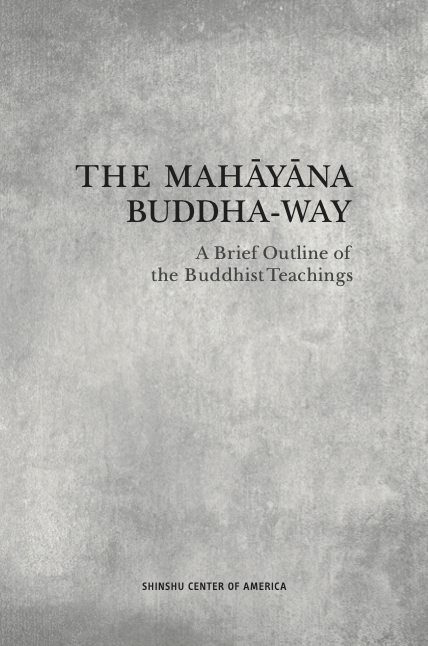
- Edition: 1st
- Published: 2022
- ISBN: 978-0-9995266-6-8
- Price: US$20.00
[From the Preface]
The previous edition of this book, called Daijō no butsudō 大乗の仏道 (The Mahāyāna Buddha-Way), was part of a multivolume series of study materials for the kyōshi, or fully ordained priests, of the Shinshū Ōtani-ha (Higashi Honganji). Its ambitious goal was to present the full range of Buddhist doctrinal and philosophical thought from the Āgama sutras to Mahāyāna Buddhism. This theme was taken up in light of Shinran’s characterization of the Shinshū teaching when he said that “The true teaching of the Pure Land is the highest attainment [of the Way] within the Mahāyāna tradition” (Mattōshō 末灯鈔). The first edition of it was generally well received and garnered favorable reviews. Since then, however, decades have passed since it was first published, during which time significant advances have been made in the field of Buddhist studies. As a result, we felt it was necessary to issue the present revised edition of the book that would better reflect the latest findings in the field of Buddhist philosophical thought.
When revising the book for the new edition, one point that we constantly bore in mind was the connection between the Buddhist teaching as taught by Śākyamuni and the Buddhist teaching clarified by Shinran. It strongly impacted our plans and made us put more energy into examining the systems of philosophical thought underlying Śākyamuni’s teaching. We especially sought to go into greater detail as to how the seeker’s mind (J. gudō shin or kyūdō shin 求道心; the mind seeking the way of salvation) works in the Buddhist religion. As an aspect of the mind of faith, Śākyamuni inspired the emergence of the seeker’s mind in his disciples as the foundation of their own search for enlightenment. The seeker’s mind would eventually become the basis for the bodhisattva ideal of Mahāyāna Buddhism. We also paid close attention to the real-world issues that Buddhism faced at different times in its development in an attempt to elucidate the historical background to the emergence of Mahāyāna Buddhism. At the same time, with regard to the systems of Buddhist philosophical thought established by grandmasters such as Nāgārjuna (c. 150–250 ce) and Vasubandhu (c. fourth and fifth centuries ce), although their tremendous contributions to the development of Mahāyāna Buddhism go without saying, we have kept our references to them to a minimum, since there are already numerous studies on them available elsewhere. As for the history of the assimilation and development of Buddhism in China, we have basically followed the presentation of the previous edition and have made only a few revisions to it. Although this new edition may still leave much to be desired, we wish to give readers an idea of our intentions in compiling this revised edition in hopes of possibly receiving feedback for improving future editions. We also wish to express our sincere thanks to the contributing authors. Parts one and two of the revised edition were written by Miyashita Seiki and part three was by Oda Akihiro, both of whom are well-known Buddhist scholars on the faculty of the Ōtani University, Kyoto.
The Seeker: The Life Story of Shinran Shonin – Part 1
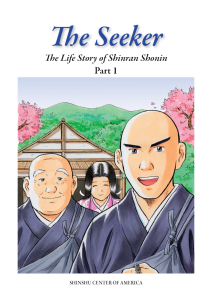
- Edition: 2nd
- Published: 2018
- ISBN: 978-0-9995266-2-0
- Price: US$10.00
This volume provides a vivid description of the young days of Shinran, who is revered as the founder of Jōdo Shinshū, spanning from his childhood through his early thirties.
The story includes his childhood difficul- ties, the struggles for true enlightenment in the Buddhist path, the first meeting with his lifetime partner, Eshin, the life-changing encounter with his teacher, Hōnen, and the daunting challenges their group is about to face…
This book was originally published in Japanese as Manga shūso shinran shōnin, vol. 1 by Shinshū Ōtani-ha Nanba Betsuin, Osaka, Japan in 2008.
The Seeker: The Life Story of Shinran Shonin – Part 2
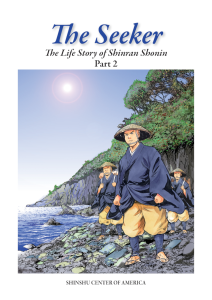
- Edition: 2nd
- Published: 2022
- ISBN: 978-0-9995266-7-5
- Price: US$10.00
The content of this volume is focused on the government persecution of his teacher, Hōnen, and some of his disciples including Shinran. As a result of the persecution, Shinran was forced to live a life in exile when he was thirty-five years old. But he eventually discovered the true meaning of Hōnen’s teaching through his relationships with the local people.
This book was originally published in Japanese as Manga shūso shinran shōnin, vol. 2 by Shinshū Ōtani-ha Nanba Betsuin, Osaka, Japan in 2009.
The Seeker: The Life Story of Shinran Shonin – Part 3
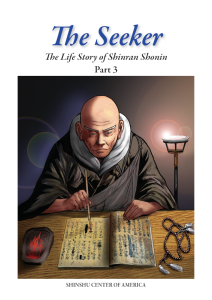
- Edition: 1st
- Published: 2015
- ISBN: 978-0-692-36623-3
- Price: US$10.00
While living in exile, Shinran learns of the death of Hōnen, who had moved back to Kyoto. Heartbroken at the loss, Shinran decides not to return to the capital, but instead moves to Kantō, a newly emerging region, for better access to the latest Buddhist resources to deepen his understanding of Hōnen’s teaching. Although he is confronted by many challenges both from inside and outside of the San- gha, Shinran’s determination to carry on the torch of his late teacher’s teaching never wavers…
This book was originally published in Japanese as Manga shūso shinran shōnin, vol. 3 by Shinshū Ōtani-ha Nanba Betsuin, Osaka, Japan in 2010.